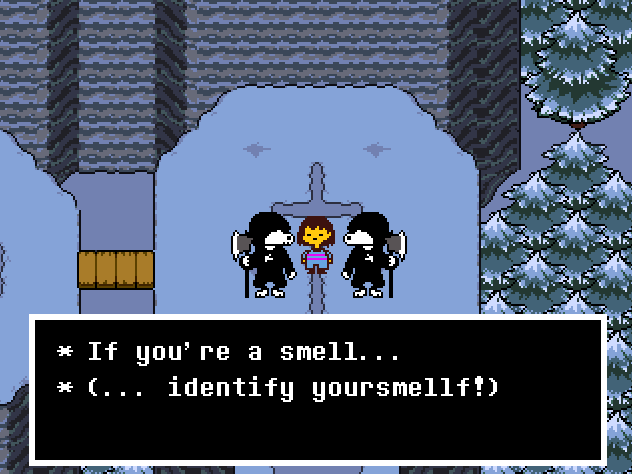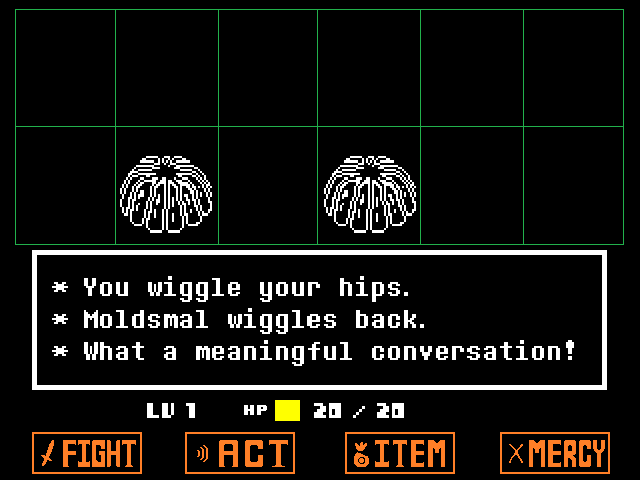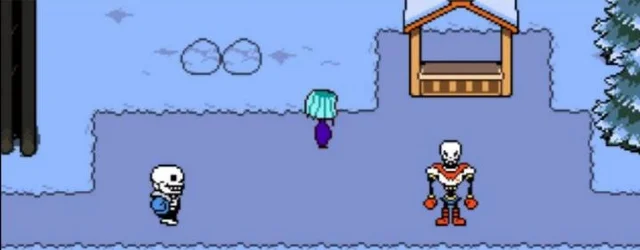(spoilers ahead if you haven’t played the full game or have read/experienced the main endings!)
When Undertale was first released in 2015, I was vaguely aware of it through my middle-school affinity for Homestuck (yes, I was an avid reader), which creator Toby Fox was a part of. I didn’t pay it too much mind until it blew up in 2016, but my teenage self hesitated to spend the money on a game I wasn’t sure I’d be good at. So I did what I (still) do best: watch playthroughs and go on a wiki deep dive. After many long hours, I found myself fascinated by the larger story and how it took my expectation of typical “fight the enemy” games and turned it on its head.

Fast forward to this past week, where I played the game for the first time. I did a few meta things since I already know the overall lore and plot, such as naming my character Chara and explicitly ignoring Flowey’s instructions. I made it past the intro, and just got to the mini boss fight with Dogamy and Dogaressa outside of Snowdin. Already, I dismissed any assumptions that I had made about the game being seemingly easy. Back then, I thought: “Oh looks like you just control this heart with your arrow keys to dodge attacks, and you can also just talk to the enemy. Doesn’t look too bad.” I sorely underestimated how hard it was, particularly with a Macbook’s tiny up and down arrow keys. I had already died multiple times before the first mini boss, and decided to take a break after I died to the Dogi 5 times in a row. I certainly had an increased sense of respect for all players of Undertale, and for all endings.
In my play time, I knew that I couldn’t put myself through trying any other ending but the True Pacifist ending, even though I knew that I wasn’t able to play through Undertale once during the week. I didn’t fight and hurt a single monster that I encountered, even in the Ruins intro. I was taken aback by all the tips and foreshadowing in the intro, from Froggit telling you to spare when you can, to encountering the toy knife. The game hints at some critical aspects of the endings early on, truly laying out the options to the player. While I knew that I had to spare all enemies in order to truly achieve a pacifist run, I was surprised by having to learn all the different interactions with monsters in order to enable the spare option. I enjoyed discovering them; it felt like getting to know the fun, particular quirks about a person. It only endeared each monster to me, and I was determined not to hurt anyone if I could avoid it. It also made me aware of how much more time it would take. It is simple to just go into the game and believe that you should fight everyone; after all, if you’ve played similar games with monster encounters (i.e. Pokemon), you probably are used to the format of “attack and defeat the opponent” in order to gain rewards. Truthfully, had I not already read/watched about Undertale in advance, I would’ve fought and defeated a number of monsters until I realized that there was more to fighting them. Attacking was the short and straightforward way to winning an encounter; talking to them, dodging their attacks, and learning their quirks in order to spare them took significantly more time.

I think that this is the core of how Undertale elegantly incorporates player actions and choices into the resulting ending of the game. If you didn’t pay attention to the monster’s reactions, dialogue, or behaviors, you might never begin to see them as relatable creatures. It is when you go out of your way to understand them, despite their (defensive?) attack sequences, that you can see the monsters for what they are: endlessly diverse, unique beings who have adapted to life here. Ultimately, putting in all that work (plus going through either of the other two endings) results in the True Pacifist ending, and rightfully so.
I find that the consequences of your actions become starkly clear if you kill nearly all the monsters you encounter (and thus, set yourself on the path of the Genocide ending). When I originally watched those playthroughs, I was truly horrified to see how the monsters reacted to you and how the world changed in response. After all, wouldn’t you react similarly if you heard that there was someone killing others indiscriminantly? You would hide or run to keep yourself safe, and if you felt defensive, you would likely try to stand up against them in order to protect others. That is exactly what the monsters did in response, which only humanizes them to the player. Upon reflection, I wondered what it took for the first players of Undertale to achieve the full Genocide ending. The game actively changes as your character goes down an increasingly bloody path, and I struggled to understand how anyone could go that far without any personal struggle as they harmed and killed everyone in their path. Treating the game as procedural rhetoric, as suggested by Ian Bogost, I suppose that it should be within the player’s will and choice to notice these changes and intentionally choose to keep going, in order to see where their actions will take them. Undertale provides that play space, in a sense, to allow others to feel and experience the complexity of being increasingly ruthless and apathetic to those around you. It gives the player the chance to uncover different narratives, from the neutral, to the pacifist, to the genocide routes, in order to come to a larger understanding of the story as one about loss, overcoming it, bonding with those around us, and the hope that comes from those bonds.
I recently had conversations with friends about our love for Undertale, and found out that there are a few fanmade simulators online for particular boss fights from the game. I’ve linked two below if anyone is interested! I’ll certainly turn to them when it comes time for me to face these bosses…one day!
Bad Time Simulator (Sans Boss Fight): https://jcw87.github.io/c2-sans-fight/ Unfair Undyne (Undyne Boss Fight): https://doodle-pile.gitlab.io/unfair-undyne/v0.99/



Hi Annie,
I loved how you pointed out the different narratives: genocide, neutral, and pacifist. I do think playing like a pacifist does take a significantly longer time and requires you to actually interact and immerse yourself with the interactable monsters, as you pointed out. After my first run through the game, I think I ended up playing more neutral, killing some monsters and sparing others. In my future tries of the game, I would like to try a completely violence-free and violence-ful(??) version to see the outcomes myself. Which version would you like to try in the future?
I also didn’t realize the two dogs were the first mini boss! I also died to them a few times. Their attack with the two axes were really hard to avoid for sure.
I’m stuck on the first two dogs and have been able to get out of that screen yet! I thought what was most insightful from your response was how you mentioned “If you didn’t pay attention to the monster’s reactions, dialogue, or behaviors, you might never begin to see them as relatable creatures.” I definitely noticed this because I didn’t realize that the characters had so much context and feelings behind them, and whenever I was getting frustrated I started to have to remind myself that these might be real characters.
Hi Annie, I thought what you pointed out about the consequences of your actions becoming clear was really interesting, and I think that applied whether you kill all of the monsters that you encounter or you choose to spare all of them. I think that’s part of what makes Undertale such a unique RPG, where it feels like you are in control of the narrative that takes shape based on what you choose to do, rather than the narrative being set and unchanging independent of what you choose to do like almost all RPGs are. Killing all mobs you encounter in an RPG is a very normal thing to do, and we feel almost nothing for it. But the fact that you found it horrifying to see how the monsters reacted to you and how the world changed around you is a testament to the very intentional procedural rhetoric woven into the game.
Hi Annie, you make a interesting point about how play throughs don’t always exhibit how difficult a game actually is. After playing Undertale myself, I watched the Sans boss battle. While it was looked difficult it felt like something I could do. I tried the simulator that you linked and I couldn’t even get passed the first attack. I also didn’t connect the meaning behind the toy knife until now so thank you for that!
Hey Annie, it was really interesting to read the perspective of someone who came in knowing more of the ins and outs of the game + how that changed your perspective/approach. You started with being set on the True Pacifist route while I came in knowing nothing and just kinda killed or spared randomly (more of the former though). I like how you talked about player intent and the deliberateness in choosing to go forward despite consequences, and how that complexity of emotion really feeds into the procedural rhetoric of Undertale. I wasn’t on the Genocide route so I couldn’t see more of the devastation of my actions, but I felt a sort of strange connection and pity for the “enemies” I had to fight.